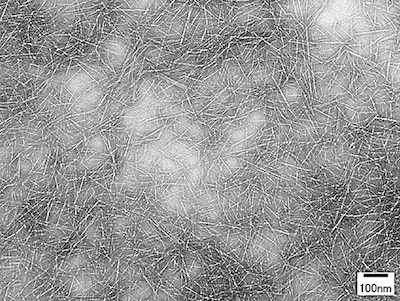Japanese paper firms take new approaches to cellulose fiber reinforcement
One player questions the need for true nanofiber reinforcement, suggesting micro or even millifibers might be a viable alternative.
July 17, 2018

Flexible plastic and corrugated paperboard packaging supplier Rengo Co., Ltd. (Osaka, Japan) has leveraged its cellulose production technology to develop a cellulose nanofiber (CNF) via an intermediate material.
|
Cost remains an issue with cellulose nanofibers, but progress is being made. |
In developing its CNF, Rengo focused on production technology used to manufacture cellophane at its Takefu Plant in Japan, that proceeds via the intermediate “xanthated” CNF (XCNF). This intermediate material has xanthate groups in its cellulose molecules, but it is possible to remove these groups with a simple process to convert XCNF into CNF like that made from pure cellulose. Targets of the xanthated CNF includes composite materials for automotive.
Typically made by “microfiberizing” the cellulose contained in wood cellulose fiber to the nanometer level using chemical or mechanical processes, CNF is said to have one fifth the weight of steel but five times its strength. On the downside, however, production costs remain high, but Rengo hopes to work with companies and universities on fundamental research and product development in order to commercialize the XCNF material.
Fellow Japanese company Mitsubishi Paper Mills, meanwhile, is taking a different approach to reducing the cost of CNF, which currently costs around $90/kg. Yasuyuki Oku, Group Leader at the company’s Marketing & Incubation Group, says that lower cost cellulose microfibers, or even millifibers, can adequately reinforce thermoplastics for many applications and they can be incorporated into the polymer matrix much more easily than CNFs, particularly when exploiting its papermaking expertise. Japan’s Ministry of Economy, Trade and Industry (METI) has set a target of reducing the cost of CNF to JPY400–500/kg ($1.60–2.00/lb.) by 2030 but there are some in the industry that think this goal is challenging. Adoption of cellulose microfibers might be a good alternative.
Mitsubishi Paper Mills already offers cellulose fiber-reinforced polypropylene (PP) compounds on a commercial basis with its Cellulomix series. Its high purity cellulose fiber PCV30-F PP compound offers reinforcement levels of 10%, 20% and 30% with tensile strengths of 36, 45, and 56 MPa, respectively, versus 32 MPa for neat PP resin. Heat distortion temperatures are substantially improved from 110°C (at 0.45 MPa) to 127°C, 145°C and 154°C, respectively. Compared with a standard PP grade’s MFR of 60, MFRs of the three grades are 14, 2 and 1, respectively. Mitsubishi Paper Mills also offers wood pulp-filled PP grades that are lower in cost with mechanical properties that are slightly down on the other grades.
Mitsubishi Paper Mills is also active in the application of recycled carbon fiber in PP thermoplastic compounds. PP reinforced with virgin carbon fiber is expensive and can find it hard to compete with carbon fiber-reinforced polyamide (CF-PA) compounds on a cost versus performance basis.
Mitsubishi Paper Mills is recovering carbon fiber waste such as trimming from thermoset composite manufacture and fiber extracted from discarded composite parts, and press-forming it with PP film layers into multi-layer CF-PP roll stock that can be further processed into three-dimensional press-formed parts or even used in insert molding or back molding processes. The company’s Carboplus Repro roll product has a base weight of 30–100 g/m2 (thickness: 450–1500 µm and CF content of 50–90wt%). The product using recycled CF retains 90% of the mechanical attributes of CF-PP roll stock incorporating virgin CF.
About the Author(s)
You May Also Like





